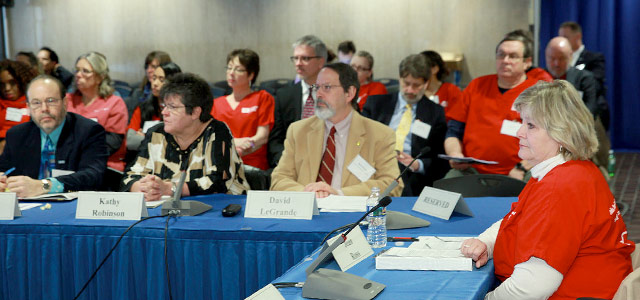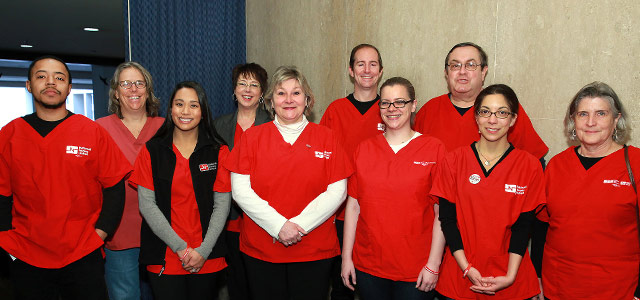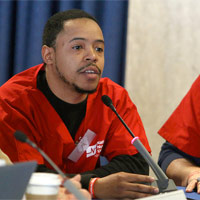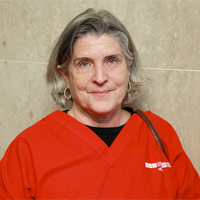Blog
Big News: NNU Nurses’ Petition Granted for National Standard to Prevent Workplace Violence

RNs testified in D.C. today on workplace violence, as Secretary of Labor David Michaels made an announcement that could save nurses’ lives.
Kicked in the chest by a combative patient. Choked with her own stethoscope. Left to fend for himself when a visitor arrived at the hospital with a gun. These are some of the personal experiences shared today by NNU nurses from around the country at the U.S. Department of Labor’s Occupational Safety and Health Administration (OSHA) stakeholder meeting in Washington, D.C. on workplace violence in healthcare settings.
“I’m lucky and grateful that [a colleague] was there to run for help,” testified Mindy Blandon, RN, of D.C., whose stethoscope was pulled tight around her throat by a patient having an adverse reaction to medication. “When help arrived, it took multiple staff to pry his fingers open to release the stethoscope, and free me … When it comes to keeping health care workers and our patients safe, we cannot rely on luck. What we need is a strong national workplace violence prevention standard.”
In light of an epidemic of violence against healthcare workers, NNU formally petitioned OSHA, in July of 2016, to enact just that standard. On the eve of today’s stakeholder meeting, the nurses were greeted with a piece of good news. Assistant Secretary of Labor David Michaels announced—as a final act in his last day in office—that OSHA will be granting National Nurses United's (NNU) petition.
"I agree with [NNU] that workplace violence is a serious occupational hazard that presents a significant risk for healthcare and social assistance workers,” said Michaels in a letter to NNU Health and Safety Director Bonnie Castillo, RN. “OSHA is granting [NNU’s] petition and will commence rulemaking to address the hazards of workplace violence in the healthcare and social assistance industries."
What does the granting of this petition mean for nurses across the country? It means that OSHA's rulemaking process—putting together a proposed series of regulations to which hospitals would be held accountable—will begin now, with RNs and other healthcare workers having many opportunities to provide testimony at future hearings.
It’s a process already familiar to California RNs. Jordan Barab, Deputy Assistant Secretary of Labor, gave “kudos” to the California Nurses Association/NNU, which sponsored a law, introduced by now California Secretary of State Alex Padilla, which is seen as the most far-reaching violence prevention plan in the nation. With the law now codified in California regulations, California healthcare employers must develop a comprehensive workplace violence plan emphasizing prevention, training, and worker participation.

“Congratulations to NNU for shepherding our groundbreaking California legislation as a national model to protect all hospital nurses, other healthcare workers and patients,” said Padilla today.
Castillo emphasized that one state is only one step in a movement to protect all nurses.
“Our nurses fought hard for the protections we now have in California, and we will not stop fighting until those workplace violence protections exist at the federal level,” said Castillo. “That’s why we applaud OSHA for taking this important step forward today, to protect healthcare and social assistance workers—as well as patients and their families—all across the country. An enforceable workplace violence standard will save lives.”
Want to join the fight to protect nurses? National Nurses United is a leader in health and safety, winning landmark legislation in the areas of staffing, safe patient handling, infectious disease and workplace violence prevention. Nurses across the country are invited to join NNU’s Nurses Health & Safety Campaign, for the latest news and action opportunities, at nationalnursesunited.org/state/health-and-safety
Read more from testimonies NNU nurses gave today in D.C.
“Threats of violence, and violent acts themselves, can take a dangerous physical and emotional toll on the healthcare workers who take care of our sick, our injured, and our dying … This reality hit home for our union in 2010, when Cynthia Palomata, a registered nurse working at Contra Costa County Jail in Martinez, California died as a result of preventable workplace violence. Cynthia was hit on her head with a lamp after she tried to help an inmate who was faking a seizure. Had the lamp been affixed or lighting recessed, there may not have been a ready weapon available to cause this tragedy …
W e cannot downplay the importance of staffing levels in decreasing workplace violence incidents. Throughout nearly every state in America, hospitals do not meet the nurse-to-patient ratios that are necessary for quality patient care and safety. Increasing staffing must be a priority in order to protect against workplace violence.”—Jean Ross, RN and NNU Co-President, Edina, Minnesota (photo right)
e cannot downplay the importance of staffing levels in decreasing workplace violence incidents. Throughout nearly every state in America, hospitals do not meet the nurse-to-patient ratios that are necessary for quality patient care and safety. Increasing staffing must be a priority in order to protect against workplace violence.”—Jean Ross, RN and NNU Co-President, Edina, Minnesota (photo right)
“A patient family member came to visit the patient with a firearm and two clips on his waist. Immediately, we contacted security, nursing supervisors, and the unit manager. The patient and the armed man starting arguing, which scared the nurses. They fled to the back of the unit, to a staircase, to hide in the event of a shooting.
 Security arrived and spoke to the armed man. Security told us that the armed man was a police officer. But the armed man didn't show any law enforcement identification, and was not in uniform … Neither my supervisor nor the unit manager did anything to help… I have yet to see a written policy on workplace violence at [my hospital]… We need OSHA to require that hospitals have a plan for situations like these.” —Jonathan Lee, RN, Washington, D.C. (photo left)
Security arrived and spoke to the armed man. Security told us that the armed man was a police officer. But the armed man didn't show any law enforcement identification, and was not in uniform … Neither my supervisor nor the unit manager did anything to help… I have yet to see a written policy on workplace violence at [my hospital]… We need OSHA to require that hospitals have a plan for situations like these.” —Jonathan Lee, RN, Washington, D.C. (photo left)
“The patient ripped out of her restraints, pulled out one of her IVs, tore her gown off, and got out of bed. She kicked me in the chest and stomach multiple times. It took approximately six people to re-restrain her to the chair.
“Were it not for the patient’s loud screaming and cursing, my co-workers may not have known to come help me. The patient was also at risk of harm, and for 30 minutes, most of the nurses and other staff on the unit could not attend to their own highly acute patients because we did not have properly trained personnel from outside the unit who could help handle combative patients … Predictable and preventable violent incidents such as these should never occur.” —Alysha Shin, RN, Los Angeles, CA
The patient was swinging, hitting me, scratching me, spitting, pinching, anything she could do to lash out at me…As a result, I sustained a serious injury to my sciatic nerve and piriformis muscle. I was on work restriction for months, not able to lift more than 20 pounds. I am now back in physical therapy at my own expense.
 The story I just told is not an isolated incident!
The story I just told is not an isolated incident!
My coworkers and I do not feel that we work in a safe environment.
It should be mandatory that healthcare facilities have a preparedness plan in place to manage potential and actual violent situations to reduce the safety risks to nurses, other staff and the patient. Additionally, for this plan to be effective, staff would have input, receive interactive education and training, and rehearse it regularly so that we are purposefully acting – not just reacting – to manage workplace violence. —Nora Jordan, RN, Bemidji, Minnesota (photo right)
“The patient was using a pain relief button. It has a push-button device that has a long cord for the patient to hold. At the end of the cord, there is a four or five inch plastic node. The patient started swinging the device erratically, trying to hit me with it.
 He then grabbed the ends of my stethoscope, which was hanging around my neck. He pulled at each end, choking me … It was a scary experience and left me shaken. But I was also frustrated because there were so many ways in which this could have been prevented.”—Mindy Blandon, RN, Washington, D.C. (photo left)
He then grabbed the ends of my stethoscope, which was hanging around my neck. He pulled at each end, choking me … It was a scary experience and left me shaken. But I was also frustrated because there were so many ways in which this could have been prevented.”—Mindy Blandon, RN, Washington, D.C. (photo left)